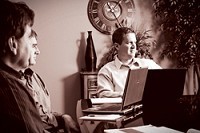Ozark-based Healthcarefirst more than tripled its revenues in the last year through two strategic acquisitions within seven months of each other.
President and CEO Bobby Robertson predicted the growth curve in early 2009 – on the heels of a private equity infusion by new majority owner The Riverside Co. – and the plan came to fruition this past year through Healthcarefirst’s June purchase of Baton Rouge, La.-based Lewis Computer
Services and a January buy of St. Paul, Minn.-based Care Facts Information Systems Inc.
The result of these acquisitions is a home care and hospice software company with $23 million in revenues, 1,200 clients and 130 employees. In the Lewis deal, Healthcarefirst nabbed a company nearly twice its size.
“Acquisitions have become part of our growth in addition to historically strong organic growth,” Robertson says, referring to the company’s nearly $1 million annual revenue increases since 2004.
Healthcarefirst’s signature product is its Web-based software – a break from the client-server models that have historically served the industry.
“We’ve found that when people are switching client-server-based software, they’re looking at Web-based solutions nowadays,” he says.
Seven-year Healthcarefirst client Katy Ramsey of Angmar Medical Holdings says Web-based software provides instant access to data, and changes to records can be seen immediately by those logged in.
“We’re on real time,” says Ramsey, the director of billings and software training for Mansfield, Texas-based Angmar Medical, which actively purchases home health agencies and now has 23 firms under its umbrella.
“I’m able to access all of our agencies’ data together,” she says, noting that with a single log in, she can view records of 5,000 patients.
Ramsey says Angmar upgraded last year to Healthcarefirst’s latest software version, and the automated system converted new agencies in a week, compared to the month-long manual process.
Healthcarefirst officials have been working to integrate its recently acquired companies and their products, such as Lewis products that mine clinical data for errors and its Medicare claims review system.
“These acquisitions create a lot of synergies where we have products that can be cross-sold to benefit the clients of each of these companies now part of Healthcarefirst,” Robertson says while on a visit to Healthcarefirst’s Baton Rouge, La., satellite office, the former Lewis headquarters. “We’re integrating them very fast.”
The Lewis buy, for instance, made available an accounts receivable platform that Angmar Medical bought into, according to Ramsey.
Healthcarefirst also has added products and services – such as billing and coding outsourcing, and a physician’s portal for electronic communication – in part by incorporating the strengths of its freshly acquired peers.
Robertson says his role hasn’t changed. He’s involved in setting a vision and directing the company but admits he leans on his board member peers and staff directors for implementation steps.
He identifies a core group of executives led by Pat Logan, Chad Albert, Cheri Whalen, Stan Harter – the original four vice presidents – and recruited executives John Heslin, a financial officer who worked in St. Louis and New Zealand, Staci Hartman, a client services manager who worked for Dell, and David Garcia, a salesman and marketer who worked with clinical software companies.
“When we moved to Springfield, we attracted some very talented individuals,” Robertson says of Healthcarefirst’s 2005 relocation from Texas. The company relocated to Ozark in 2006.
The firm now employs more than 30 software developers to keep the technology humming along.
The average employee salary is $63,000, Robertson says, and 65 work at the headquarters.
Robertson says Healthcarefirst is not in active acquisition mode but officials are scanning the market for opportunities.
The home health industry itself is growing, partly in preparation for baby boomers who need care.
“Now, they’re starting to come in and technology has allowed home care for these patients in their homes, where they want to be, in just as an efficient way,” Robertson adds.
Click here for the complete 2011 Dynamic Dozen overview.[[In-content Ad]]
